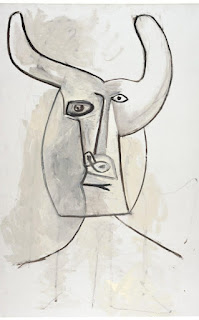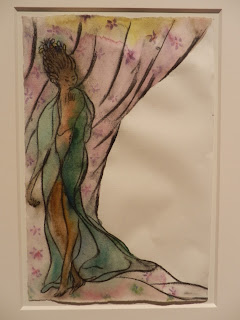Friday, 30 June 2017
Ferrari-Hardoy/Kurchan/Bonet: Butterflies Through Other Eyes #33
The Butterfly Chair, BKF or Hardoy Chair, originally designed in 1938 by a trio of architectural designers - Jorge Ferrari-Hardoy, Juan Kurchan, and Antonio Bonet, is one of the most famous chair designs of the 20th Century and was quickly acknowledged as a design classic. It was mass produced in the 1950s with many manufacturers producing their own versions of the original, and very popular among teenagers and young couples wanting different, modern furniture to that of their parents. This Butterfly chair consists of a black enameled tubular solid steel frame with a suede or leather sling seat. It is light weight, and apparently very comfortable, like a hammock. This version of the Butterfly chair was manufactured by Knoll in the USA during the 1970s.
Tuesday, 27 June 2017
Picasso: Minotaurs and Matadors
If all the ways I have been along were marked on a map and joined up with a line, it might represent a Minotaur. - Pablo Picasso
This is a particularly good exhibition at Gagosian Mayfair. It is all the stronger for focusing on a particular aspect of Picasso's oeuvre - the bull/Minotaur - the mythic creature Picasso readily identified with - at turns aggressive and lusty, at others tender, and all too vulnerable. Every medium that the artist ever worked in is represented here - paint, print, sculpture, ceramics, and even tapestry, displaying just how endlessly creative and inventive he was. And although not everything he touched turned to gold, he truly was nonetheless a/the giant of 20th century art.
The painting above, Minotaur in a Boat Saving A Woman, (1937) was my favourite of the paintings featured in the show. I loved the cool, chalky, restricted colour palette, and the loose, inventive mark-making of the drawing. The portraits of matadors below, were I felt, quite weak and restrained in comparison.
The selection of prints (mainly etchings), are perhaps the strongest display of Picasso's artistic skills in the exhibition. We are able to observe examples of the lusty, priapic Mintouar indulging in Bacchic excesses from the Vollard Suite, as well as the darker, more troubling prints from his La Minotauromachie series, when the artists personal life was in turmoil. His drawing, and compositional skills are second to none and really displayed to their best in these series of etchings featured in this show.
This statue (above), is so brilliant in its simplicity and appropriation of found materials. The bicycle saddle and handlebars juxtaposed, perfectly represents a bull, and it took Picasso's unique artistic eye to realise this, possibly perchance, through the influence of Surrealism. I view it as yet more evidence of Picasso's genius in this show. This is definately in my opinion one of the best exhibitions in London this summer, beautifully presented salon-style against a backdrop of green curtains in the Gagosian space, and curated by no less than Sir John Richardson - Picasso's official biographer.
Picasso: Minotaurs and Matadors
until 25th August
Gagosian
20 Grosvenor Hill
London
Saturday, 24 June 2017
Clifford & Rosemary Ellis: Butterflies Through Other Eyes #32
Some really great butterfly book jacket illustrations from Collins' New Naturalist series by dynamic husband and wife design/illustration duo Clifford & Rosemary Ellis (1907-1985 and 1910-1998 respectively).
(and a dragonfly).
Tuesday, 20 June 2017
Chris Ofili: Weaving Magic
To the National Gallery to see this huge tapestry - The Caged Bird's Song - a collaboration between artist Chris Ofili, and the weaving skills of Dovecot Tapestry Studio. The tapestry a triptych, over 5 metres long, took two and a half years to complete, and was commissioned by The Clothworkers' Company - a London livery company with a history that dates back five hundred years. The Clothworkers' Company will be the tapestry's permanent home when the exhibition finishes.
The tapestry's imagery reflects Ofili's interest in classical mythology, and contemporary 'demigods', together with the landscape of Trinidad his adopted home. The title of the tapestry refers to the first volume of Maya Angelou's autobiography, and the practice among Trinidadian men of carry around caged songbirds. Apparently Ofili was reluctant to accept the commission, and initially turned it down. He eventually agreed to take it on, but I'm not sure how comfortable he was with the project as some of the preparatory sketches do seem slight, or a little restrained in comparison to his earlier works.
The first room of the exhibition features those preparatory sketches, alongside the finished design. It's interesting to see the inclusion of footballer Mario Balotelli as a mythical God/cocktail waiter at the top of the composition, who seems to be the source of the waterfall in the tapestry. It looks as though Ofili watered down certain elements of the final tapestry, or had a change of heart, as the couple in the central panel seemingly engaged in a certain lovemaking position in the preparatory sketches, look to have been censured in the final tapestry. (Pictures 6, and 18 below).
The final largest room features the completed tapestry, the colours of which really glow in contrast to the background frieze designs of grey exotic (transgender?), female figures - some bearded and moustachioed - who pose and preen quite suggestively. These larger than life ladies were painted directly onto the walls of the National Gallery's Sunley Room by the Royal Opera House's scenic painters.
The tapestry itself is a triumph, and an impressive display of the Dovecot Tapestry Studio's weaver's art. The commitment of the weavers to this project I think enhances the original Ofili watercolour design by heightening the colour, and exaggerating the lovely bleeds, and wet-in-wet effects of his watercolour technique. They have caught, and interpreted Ofili's original sketch sensitively and beautifully.
Chris Ofili: Weaving Magic
until 28th August
National Gallery
Trafalgar Square
London
Subscribe to:
Comments (Atom)






















































